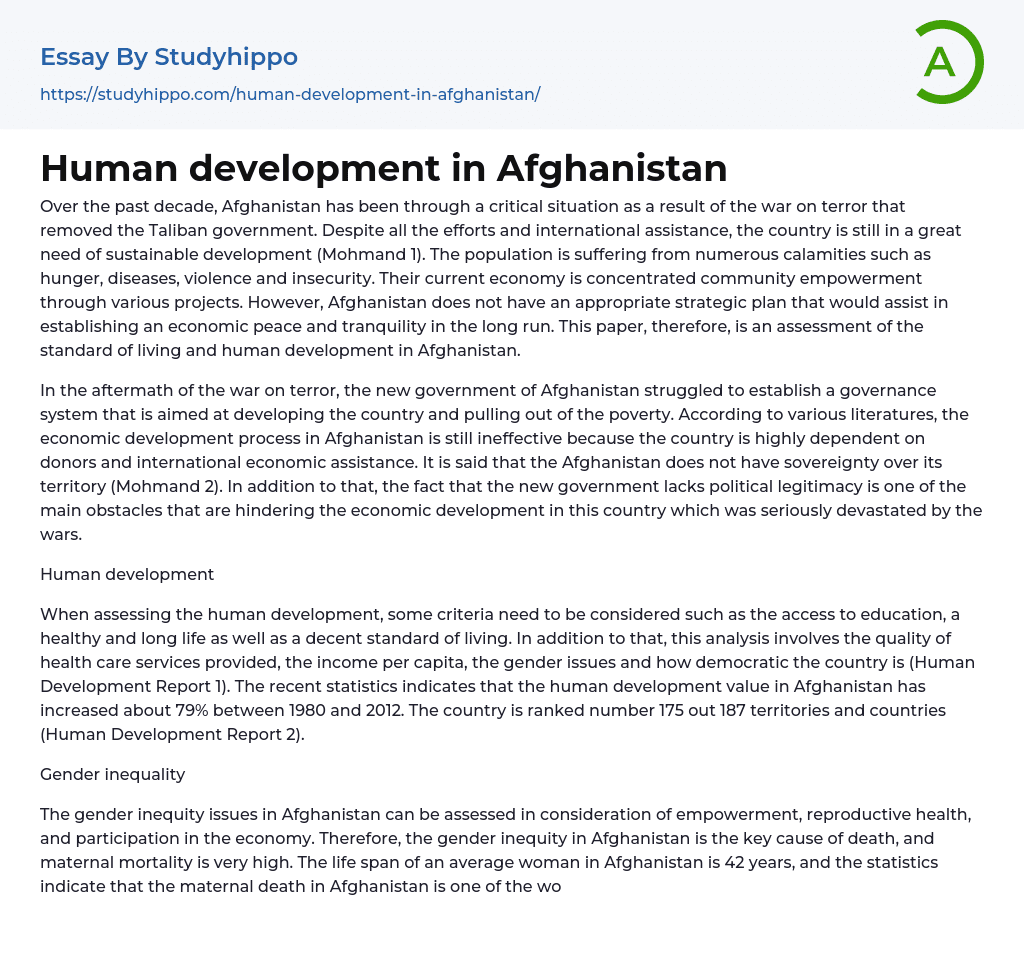Despite the removal of the Taliban government and international assistance provided in recent years, Afghanistan remains in a critical state due to the war on terror. The country still grapples with hunger, diseases, violence, and insecurity among its population (Mohmand 1). Currently, efforts are being made through various projects to empower communities and tackle these challenges.
However, Afghanistan lacks a suitable strategic plan to establish long-term economic peace and tranquility. This paper assesses the standard of living and human development in Afghanistan, following the war on terror and the challenges faced by the new government in developing the country and overcoming poverty. Numerous sources indicate that Afghanistan's economic development process remains ineffective due to its heavy reliance on foreign aid and donors. It is argued that Afghanistan lacks sovereignty over its territory (Mohmand 2).
The lack of political legitimacy
...in the new government is a major obstacle to the economic development in this war-torn country.
Human development
In evaluating human development, access to education, a healthy and long life, and a decent standard of living must be considered. This assessment also includes the quality of healthcare services, per capita income, gender issues, and the level of democracy in the country (Human Development Report 1). Recent statistics indicate that Afghanistan's human development value increased by 79% between 1980 and 2012. The country holds a ranking of 175 out of 187 territories and countries (Human Development Report 2).
Gender inequality: Gender inequality in Afghanistan is apparent in multiple areas, including empowerment, reproductive health, and economic participation. This disparity is the primary cause of the country's high maternal mortality rate, leading to an average lifespan of 42 years for Afghan women (Morga
2). The data demonstrates that Afghanistan has one of the highest global rates of maternal deaths at around 1600 deaths per 100,000 live births. Furthermore, there remains an educational divide between men and women in Afghanistan.
According to a recent report, the literacy rate for Afghan women is only 16.65%, while it is 32.4% for men (Morgan 3). These low rates of literacy among women are due to cultural traditions, laws, and violence that restrict their freedom.
Access to education: UNICEF reports that nearly half of Afghan children are unable to access education, resulting in negative impacts on their health as they lack knowledge about hygiene and healthcare (DAWN, para. 2).
Since the overthrow of the Taliban regime, there has been a noticeable increase in the number of children attending school compared to previous years. However, approximately five million children in Afghanistan still do not have access to education because the Taliban regime closed many schools (DAWN, para. 5).
Unemployment rate: According to the World Bank, the average unemployment rate in Afghanistan was 10.40% between 1991 and 2015. However, it has risen to 40% in the past two years. When measuring unemployment, they take into account the number of people actively seeking employment compared to the active population in the country. Furthermore, a recent report from TRADING ECONOMICS stated that Afghanistan's inflation rate for 2016 was recorded at 3.85% (para. 3).
The mentioned inflation rate was computed using the consumer price index (CPI) formula. The recent GDP per capita in Afghanistan is $1876.64. It is asserted that when adjusted by Purchasing Power Parity, the GDP per capita equates to 11%. To achieve this GDP per capita, the adjusted GDP
is divided by the total population of the country. Multiple reports have indicated significant improvement in the Afghan economy over the last decade attributable to investments and billions of dollars from international assistance (U.S.).
Department of Defense 9). The findings of this paper suggest that Afghanistan is making efforts to rebuild its economy through education and community empowerment (Morgan 6). The government of Afghanistan is working towards establishing human rights and gender equality through initiatives funded by international non-governmental organizations and the United Nations. It is clear that the country has made progress compared to the Taliban regime.
Works cited
- DAWN,. "No School for Almost Half of Afghan Children « RAWA News". Webcache.googleusercontent.com. N.p., 2016. Web. 4 May 2016.
- Human Development Report.
The web source, "The Rise of The South: Human Progress In A Diverse World", is the first edition of the Human Development Report from 2013.
4 May 2016.
Mohmand, Abdul-Qayum. THE PROSPECTS FOR ECONOMIC DEVELOPMENT IN AFGHANISTAN: Reflections On A Survey Of The Afghan People, Part 2 Of 4. 1st ed. Salt Lake City: University of Utah, Salt Lake City, 2012.
Web. 4 May 2016.
4 May 2016.
Web. 4 May 2016.
- U.S. Department of Defense,. The Government Of Islamic Republic Of Afghanistan’S Controls Over The Contract Management Process
- For U.S. Direct Assistance Need Improvement.
The first edition of the U.S. Department of Defense was published in 2015 and is available on the web as of May 4, 2016.
- Afghanistan essays
- Africa essays
- America essays
- Asia essays
- Australia essays
- Caribbean essays
- City essays
- Developing Country essays
- Dubai essays
- Earthquake essays
- Europe essays
- Fracking essays
- Georgia essays
- Middle East essays
- Natural Disaster essays
- New Zealand essays
- North Korea essays
- South Korea essays
- Thailand essays
- Travel essays
- American Dream essays
- Barriers To Entry essays
- Capitalism essays
- Central Bank essays
- Compensation essays
- Consumerism essays
- Economic Development essays
- Economic Growth essays
- Economic Inequality essays
- Economic System essays
- Economy essays
- Employment essays
- Export essays
- Finance essays
- Free Trade essays
- Gross Domestic Product essays
- Human Development essays
- Income Inequality essays
- Industry essays
- Inflation essays
- International Business essays
- International Trade essays
- Macroeconomics essays
- Materialism essays
- Max Weber essays
- Microeconomics essays
- Minimum Wage essays
- Monetary Policy essays
- Monopoly essays
- Pricing essays




